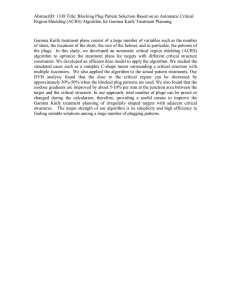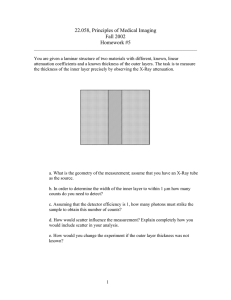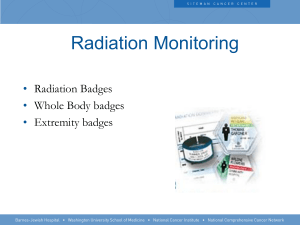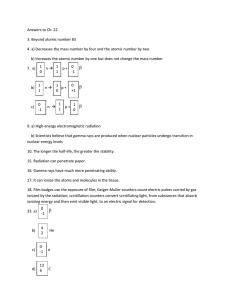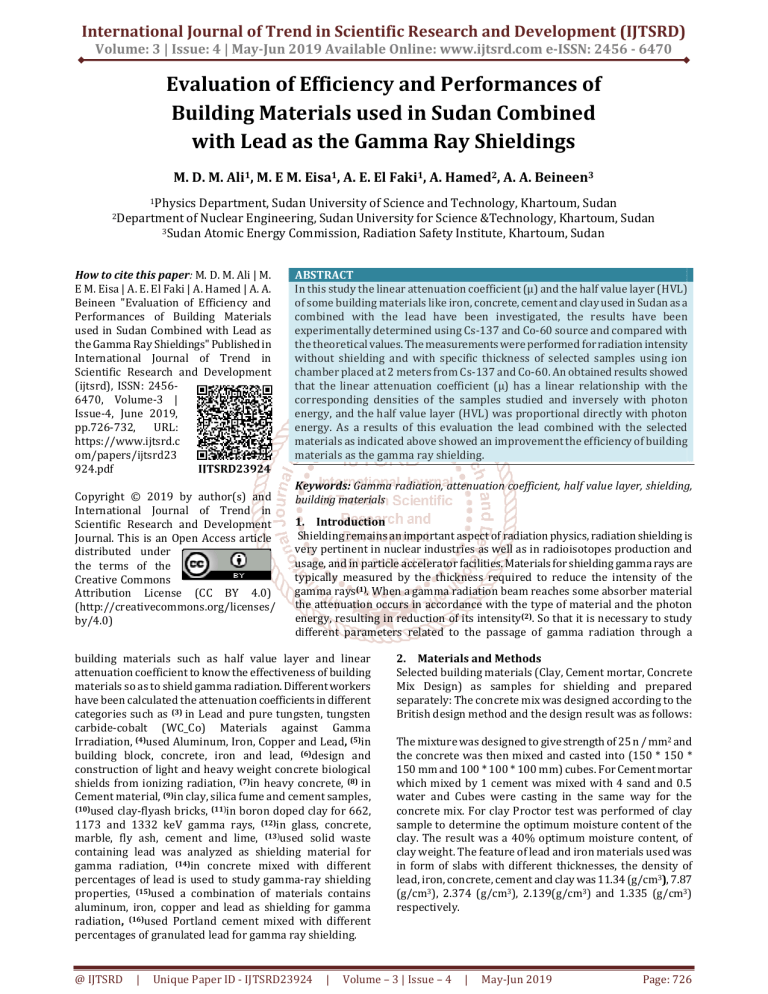
International Journal of Trend in Scientific Research and Development (IJTSRD)
Volume: 3 | Issue: 4 | May-Jun 2019 Available Online: www.ijtsrd.com e-ISSN: 2456 - 6470
Evaluation of Efficiency and Performances of
Building Materials used in Sudan Combined
with Lead as the Gamma Ray Shieldings
M. D. M. Ali1, M. E M. Eisa1, A. E. El Faki1, A. Hamed2, A. A. Beineen3
1Physics
Department, Sudan University of Science and Technology, Khartoum, Sudan
of Nuclear Engineering, Sudan University for Science &Technology, Khartoum, Sudan
3Sudan Atomic Energy Commission, Radiation Safety Institute, Khartoum, Sudan
2Department
How to cite this paper: M. D. M. Ali | M.
E M. Eisa | A. E. El Faki | A. Hamed | A. A.
Beineen "Evaluation of Efficiency and
Performances of Building Materials
used in Sudan Combined with Lead as
the Gamma Ray Shieldings" Published in
International Journal of Trend in
Scientific Research and Development
(ijtsrd), ISSN: 24566470, Volume-3 |
Issue-4, June 2019,
pp.726-732,
URL:
https://www.ijtsrd.c
om/papers/ijtsrd23
924.pdf
IJTSRD23924
Copyright © 2019 by author(s) and
International Journal of Trend in
Scientific Research and Development
Journal. This is an Open Access article
distributed under
the terms of the
Creative Commons
Attribution License (CC BY 4.0)
(http://creativecommons.org/licenses/
by/4.0)
ABSTRACT
In this study the linear attenuation coefficient (µ) and the half value layer (HVL)
of some building materials like iron, concrete, cement and clay used in Sudan as a
combined with the lead have been investigated, the results have been
experimentally determined using Cs-137 and Co-60 source and compared with
the theoretical values. The measurements were performed for radiation intensity
without shielding and with specific thickness of selected samples using ion
chamber placed at 2 meters from Cs-137 and Co-60. An obtained results showed
that the linear attenuation coefficient (µ) has a linear relationship with the
corresponding densities of the samples studied and inversely with photon
energy, and the half value layer (HVL) was proportional directly with photon
energy. As a results of this evaluation the lead combined with the selected
materials as indicated above showed an improvement the efficiency of building
materials as the gamma ray shielding.
Keywords: Gamma radiation, attenuation coefficient, half value layer, shielding,
building materials
1. Introduction
Shielding remains an important aspect of radiation physics, radiation shielding is
very pertinent in nuclear industries as well as in radioisotopes production and
usage, and in particle accelerator facilities. Materials for shielding gamma rays are
typically measured by the thickness required to reduce the intensity of the
gamma rays(1). When a gamma radiation beam reaches some absorber material
the attenuation occurs in accordance with the type of material and the photon
energy, resulting in reduction of its intensity(2). So that it is necessary to study
different parameters related to the passage of gamma radiation through a
building materials such as half value layer and linear
attenuation coefficient to know the effectiveness of building
materials so as to shield gamma radiation. Different workers
have been calculated the attenuation coefficients in different
categories such as (3) in Lead and pure tungsten, tungsten
carbide-cobalt (WC_Co) Materials against Gamma
Irradiation, (4)used Aluminum, Iron, Copper and Lead, (5)in
building block, concrete, iron and lead, (6)design and
construction of light and heavy weight concrete biological
shields from ionizing radiation, (7)in heavy concrete, (8) in
Cement material, (9)in clay, silica fume and cement samples,
(10)used clay-flyash bricks, (11)in boron doped clay for 662,
1173 and 1332 keV gamma rays, (12)in glass, concrete,
marble, fly ash, cement and lime, (13)used solid waste
containing lead was analyzed as shielding material for
gamma radiation, (14)in concrete mixed with different
percentages of lead is used to study gamma-ray shielding
properties, (15)used a combination of materials contains
aluminum, iron, copper and lead as shielding for gamma
radiation, (16)used Portland cement mixed with different
percentages of granulated lead for gamma ray shielding.
@ IJTSRD
|
Unique Paper ID - IJTSRD23924
|
2. Materials and Methods
Selected building materials (Clay, Cement mortar, Concrete
Mix Design) as samples for shielding and prepared
separately: The concrete mix was designed according to the
British design method and the design result was as follows:
The mixture was designed to give strength of 25 n / mm2 and
the concrete was then mixed and casted into (150 * 150 *
150 mm and 100 * 100 * 100 mm) cubes. For Cement mortar
which mixed by 1 cement was mixed with 4 sand and 0.5
water and Cubes were casting in the same way for the
concrete mix. For clay Proctor test was performed of clay
sample to determine the optimum moisture content of the
clay. The result was a 40% optimum moisture content, of
clay weight. The feature of lead and iron materials used was
in form of slabs with different thicknesses, the density of
lead, iron, concrete, cement and clay was 11.34 (g/cm3), 7.87
(g/cm3), 2.374 (g/cm3), 2.139(g/cm3) and 1.335 (g/cm3)
respectively.
Volume – 3 | Issue – 4
|
May-Jun 2019
Page: 726
International Journal of Trend in Scientific Research and Development (IJTSRD) @ www.ijtsrd.com eISSN: 2456-6470
Experimental setup:
The measurement was performed at secondary standard
dosimetry laboratory (SSDL –Sudan) in order to determine
the air kerma rate as radiation intensity at a reference
distance from γ source (Co-60, Cs-137) located inOB-85
Irradiator two lead attenuators are available that are placed
at the exit window of the irradiator so shielding samples was
placed at this point, and connected to Electrometer UNIDOS,
Thermometer and barometer were used to conduct this
measurement. Concerning dosimetry systems, the laboratory
has one secondary standard ionization chamber designed
and manufactured at the Austrian research centre,
Siebersdorf. This chamber was calibrated at IAEA laboratory
with its calibration traceable to the German National
Laboratory (PTB). Ionization chamber was placed at 2
meters from Cs-137 source as usual in reference standard
measurements. Measurements of linear attenuation
coefficients; γ-ray beam used here was characterized in
terms of air kerma as radiation intensity without attenuator
after that adding attenuator with constant operation voltage
400 volt , to calculate linear attenuation coefficient(17).
Linear attenuation coefficient
The linear attenuation coefficient (μ) describes the fraction
of a beam of x-rays or gamma rays that is absorbed or
scattered per unit thickness of the absorber, depend on the
composition of the attenuating material and photon energy,
and it is expressed in equation
=
Where
(1)
is the linear attenuation coefficient in(cm-1),
the thickness of the sample in (cm),
is
is initial intensity and
I is thickness intensity(18, 19). The theoretical values of linear
attenuation coefficient of combined samples calculated using
the equation below,
(2)
Where
is the linear attenuation coefficient, and
is the
thickness of combination samples.
Half value layer
The thickness of the attenuator that reduces the photon
beam intensity to half of its original value
is called the
half-value layer, HVL, and is given by
HVL =
(20, 5)
=
(3)
3. Results and Discussion
Table1. The value of Doses through different lead and iron slabs thickness by using Cs-137 source The measuring time,
temperature and pressure were 60s, 24.6 and 968.9hpa, respectively.
Lead thickness(cm)
Dose(µGY)
Iron thickness(cm)
Dose(µGY)
Frequency
0.000
474.76
0.000
474.74
10
0.154
400.46
0.202
434.58
10
0.472
274.69
0.522
373.03
10
0.812
190.42
1.036
289.54
10
0.966
164.63
1.350
249.21
10
Table2. The value of Doses through different lead and iron slabs thickness by using Co-60 source. The measuring time,
temperature and pressure were 30s, 24.6 and 968.9hpa, respectively.
Lead
thickness(cm)
0.000
1.906
Iron
thickness(cm)
0.000
0.154
1.744
0.202
1.797
10
0.472
1.428
0.522
1.602
10
0.812
1.169
1.036
1.346
10
0.966
1.079
1.350
1.202
10
Dose(µGY)
Dose(µGY)
Frequency
1.906
10
Table3. The value of Doses through different building materials cubic’s thickness by using Cs-137 source. The measuring
time, temperature and pressure were 30s, 30 and 964.7hpa, respectively.
@ IJTSRD
Thickness(cm)
Dose(µGY) through
concrete shield
Dose(µGY) through
cement shield
0
225.65
225.65
Dose(µGY)
through clay
shield
225.65
10
43.37
49.99
77.05
10
20
9.45
12.10
27.26
10
25
4.93
7.04
18.24
10
35
2.27
2.81
7.86
10
|
Unique Paper ID - IJTSRD23924
|
Volume – 3 | Issue – 4
|
May-Jun 2019
Frequency
10
Page: 727
International Journal of Trend in Scientific Research and Development (IJTSRD) @ www.ijtsrd.com eISSN: 2456-6470
Table4. The value of Doses through different building materials cubic’s thickness by using Co-60 source. The measuring
time, temperature and pressure were 30s, 34.5 and 964.8hpa, respectively.
Thickness(cm)
0
10
20
25
35
Dose(µGY) through
concrete shield
1.906
0.561
0.178
0.109
0.053
Dose(µGY) through
cement shield
1.906
0.636
0.218
0.141
0.072
Dose(µGY) through
clay shield
1.906
0.856
0.396
0.301
0.177
Frequency
10
10
10
10
10
Table5. Linear attenuation coefficient and half value layer for selected shielding materials using Cs-137 gamma rays.
Linear attenuation Standard error
Standard error
Materials
Half value layer(cm)
coefficient µ(cm-1)
(cm-1)
(cm)
Lead
1.121
0.028
0.617
0.008
Iron
0.463
0.009
1.496
0.031
Concrete
0.151
0.007
4.593
0.236
Cement
0.139
0.006
4.965
0.206
Clay
0.101
0.003
6.779
0.175
Table6: The value of Doses through different (lead + Iron) slabs thickness by using Cs-137 source. The measuring time,
temperature and pressure were 30s, 24.5 and 970.7hpa, respectively.
(Lead + Iron)
Thickness (cm)
0.000
0.154+0.202
0.154+0.522
0.154+1.036
0.154+1.35
0.472+0.202
0.472+0.522
0.472+1.036
0.472+1.35
0.812+0.202
0.812+0.522
0.812+1.036
0.812+1.350
Dose(µGY)
Frequency
237.74
182.72
157.52
122.43
10
10
10
10
105.61
127.20
110.09
86.36
74.86
87.74
76.17
59.86
51.84
10
10
10
10
10
10
10
10
10
Table7: The value of Doses through different (lead slabs +Building materials Cubic’s) thickness by using Cs-137 source.
The measuring time, temperature and pressure were 30s, 32 and 986.7hpa, respectively.
0.000
0.154+10
Dose(µGY) through
(lead+ Concrete) shield
233.23
43.79
Dose(µGY) through
(lead+ Cement) shield
233.23
47.03
Dose(µGY) through
(lead+ Clay) shield
233.23
94.50
0.154+20
0.154+25
0.154+35
0.472+10
0.472+20
0.472+25
0.472+35
0.812+10
0.812+20
0.812+25
0.812+35
15.94
4.30
2.46
31.09
11.95
3.10
1.81
22.81
9.10
2.25
1.30
16.29
6.04
3.32
33.73
12.08
4.31
2.41
24.27
9.47
3.25
1.78
58.95
20.31
13.87
67.62
42.38
14.39
9.76
47.40
28.85
9.93
6.77
Thickness (cm)
@ IJTSRD
|
Unique Paper ID - IJTSRD23924
|
Volume – 3 | Issue – 4
|
May-Jun 2019
Frequency
10
10
10
10
10
10
10
10
10
10
10
10
10
Page: 728
International Journal of Trend in Scientific Research and Development (IJTSRD) @ www.ijtsrd.com eISSN: 2456-6470
Table8: Linear attenuation coefficient and half value layer for selected shielding materials using Cs-137 gamma rays
Experimental
Theoretical
Linear
Linear
Standard Half value Standard
Standard
Half
Standard
Materials attenuation
attenuation
error
layer
error
error
value
error
coefficient
coefficient
(cm-1)
(cm)
(cm-1)
(cm-1)
layer(cm)
(cm-1)
-1
-1
µ(cm )
µ(cm )
Lead
0.727
0.040
0.982
0.053
0.737
0.040
0.971
0.053
+Iron
Lead
0.160
0.007
4.412
0.189
0.175
0.008
4.031
0.178
+Concrete
Lead
0.150
0.007
4.630
0.198
0.164
0.007
4.305
0.182
+Cement
Lead
0.115
0.013
6.066
0.628
0.127
0.023
5.580
0.910
+clay
In this study the decrease of 662, 1173 and 1332 keV gamma rays with the increase the thickness of selected materials have
been obtained, for each energy the measurements for all types of samples were carried out ten times and the average values
listed in Tables 1, 2, 3, 4, 6, and 7. Also the linear attenuation coefficients and half value layer for the all studied building
materials have been obtained for 662 keV gamma rays and the results have been listed in Tables 5 and 8, so the comparison of
experimental and theoretical of linear attenuation coefficient and half value layer have been listed also in table8.
Figures 1, 2, 3 and 4 show graphical patterns that describe how the photon was attenuated in the selected materials with
increased the thickness, through different energies of gamma ray Cs-137 and Co-60.
Figure5 shows the comparison of experimental and theoretical linear attenuation coefficient (µ) values for the selected
materials through gamma ray energy, Cs-137. The results showed agreement between experimental and theoretical readings.
In Fiqure6, shows the comparison of experimental and theoretical half value layer (HVL) values for the studied materials
through gamma ray energy, Cs-137.Also the results showed agreement between experimental and theoretical readings.
In Figure7, shows the comparison of linear attenuation coefficients (µ) values for the selected materials using gamma ray
source, Cs-137, and the variation of linear attenuation coefficients can be explained due to density-dependence of these
materials. It is observed that the lead enhance the performance of iron, concrete, cement and clay to use as the shielding
materials for gamma ray. And the comparison of half value layer (HVL) values for the selected materials using gamma ray
source, Cs-137 showed in fiqure8.
Fiqure1. Attenuation of Cs-137 gamma rays as a function of thickness through different shield materials
Fiqure2. Attenuation of Co-60 gamma rays as a function of thickness through different shield materials
@ IJTSRD
|
Unique Paper ID - IJTSRD23924
|
Volume – 3 | Issue – 4
|
May-Jun 2019
Page: 729
International Journal of Trend in Scientific Research and Development (IJTSRD) @ www.ijtsrd.com eISSN: 2456-6470
Fiqure3. Attenuation of Cs-137 gamma rays as a function of thickness through different shield materials
Fiqure4. Attenuation of Co-60 gamma rays as a function of thickness through different shield materials
Fiqure5. Comparison of experimental and theoretical linear attenuation coefficient of different shield materials using Cs137 gamma ray
Fiqure6. Comparison of experimental and theoretical half value layer of different shield materials using Cs-137 gamma
ray
@ IJTSRD
|
Unique Paper ID - IJTSRD23924
|
Volume – 3 | Issue – 4
|
May-Jun 2019
Page: 730
International Journal of Trend in Scientific Research and Development (IJTSRD) @ www.ijtsrd.com eISSN: 2456-6470
Fiqure7. Comparison of linear attenuation coefficient of selected shielding materials using Cs-137 gamma ray.
Fiqure8. Comparison of half value layer of selected shielding materials using Cs-137 gamma ray.
4. Conclusion
A combination of lead with the some building materials used
in Sudan showed an improvement in the efficiency of these
selected materials as the gamma ray shielding. Because an
investigated materials showed the linear attenuation
coefficients decrease with the increasing photon energy, and
half value layer increase with increasing photon energy for
these materials.
References
[1] Nwosu, O. B. Comparison Of Gamma Ray Shielding
Strength Of Lead, Aluminium And Copper From Their
Experimental And MCNP Simulation Result.
INTERNATIONAL JOURNAL OF TECHNOLOGY
ENHANCEMENTS AND EMERGING ENGINEERING
RESEARCH. 3, 2347-4289 (2015).
[2] Gurler, O., and U. Akar Tarim. Determination of
Radiation Shielding Properties of Some Polymer and
Plastic Materials against Gamma-Rays. Acta Physica
Polonica A. 130, 236-238(2016).
[3] Buyuk, Bulent, and A. Beril Tugrul. Comparison of lead
and WC-Co materials against gamma irradiation. Acta
Phys. Pol. A. 125, 423-425 (2014).
@ IJTSRD
|
Unique Paper ID - IJTSRD23924
|
[4] Reda, S. M. Gamma Ray Shielding by a New
Combination of Aluminum, Iron, Copper and Lead
Using MCNP5. Arab Journal of Nuclear Sciences and
Applications. 49, 211-217 (2016).
[5] Adedoyin, Oluwaseun, and Abiodun Ayodeji.
Measurement of Shielding Effectiveness of Building
Blocks against 662 KeV Photons. Journal of Physical
Science. 27, 55–65 (2016).
[6] Samarin, Aleksander. Use of concrete as a biological
shield from ionising radiation. Energy and
Environmental Engineering 1, 90-97 (2013).
[7] Aghamiri, S. M., Mortazavi, S. M., Shirazi, M. M.,
Baradaran-Ghahfarokhi, M., Rahmani, F., Amiri, A., &
Jarideh, S. Production of a novel high strength heavy
concrete using tourmaline and galena for neutron and
photon radiation shielding. International Journal of
Radiation Research. 12, 287-292 (2014).
[8] Guan, H., Liu, S., Duan, Y., & Cheng, J. Cement based
electromagnetic shielding and absorbing building
materials. Cement and Concrete Composites. 28, 468474 (2006).
Volume – 3 | Issue – 4
|
May-Jun 2019
Page: 731
International Journal of Trend in Scientific Research and Development (IJTSRD) @ www.ijtsrd.com eISSN: 2456-6470
[9] Akbulut, S., Sehhatigdiri, A., Eroglu, H., & Çelik, S. A
research on the radiation shielding effects of clay, silica
fume and cement samples. Radiation Physics and
Chemistry. 117, 88-92 (2015).
[15] Reda, S. M. Gamma Ray Shielding by a New
Combination of Aluminum, Iron, Copper and Lead
Using MCNP5. Arab Journal of Nuclear Sciences and
Applications. 49, 211-217 (2016).
[10] Mann, H. S., Brar, G. S., Mann, K. S., & Mudahar, G. S.
Experimental investigation of clay fly ash bricks for
gamma-ray shielding. Nuclear Engineering and
Technology. 48, 1230-1236 (2016).
[16] El-Hosiny, F. I., & El-Faramawy, N. A. Shielding of
gamma radiation by hydrated Portland cement–lead
pastes. Radiation Measurements. 32, 93-99 (2000).
[11] Akkurt, I., & Canakci, H. Radiation attenuation of boron
doped clay for 662, 1173 and 1332 keV gamma rays.
International Journal of Radiation Research. 9, 37-40
(2011).
[12] Singh, C., Singh, T., Kumar, A., & Mudahar, G. S. Energy
and chemical composition dependence of mass
attenuation coefficients of building materials. Annals of
nuclear Energy. 31, 1199-1205 (2004).
[13] Erdem, M., Baykara, O., Doğru, M., & Kuluöztürk, F. A
novel shielding material prepared from solid waste
containing lead for gamma ray. Radiation Physics and
Chemistry. 79, 917-922 (2010).
[14] Rezaei-Ochbelagh, D., & Azimkhani, S. Investigation of
gamma-ray shielding properties of concrete containing
different percentages of lead. Applied Radiation and
Isotopes. 70, 2282-2286 (2012).
@ IJTSRD
|
Unique Paper ID - IJTSRD23924
|
[17] IAEA, A. Calibration of radiation protection monitoring
instruments (p. 50). STI/PUB/1074 (January 2000).
[18] Akbulut, S., Sehhatigdiri, A., Eroglu, H., & Çelik, S. A
research on the radiation shielding effects of clay, silica
fume and cement samples. Radiation Physics and
Chemistry. 117, 88-92 (2015).
[19] Salinas, I. C. P., Conti, C. C., & Lopes, R. T. Effective
density and mass attenuation coefficient for building
material in Brazil. Applied radiation and isotopes. 64,
13-18 (2006).
[20] Vipan Kumar, Kulwinder Singh Mann, S. R. Manohara,
Gurdeep Singh Sidhu. INVESTIGATIONS ON SOME LOW
Z ALKALI MINERALS AS GAMMA-RAY SHIELDS.
International Journal of Latest Research in Science and
Technology. 1, 324-333 (2012).
Volume – 3 | Issue – 4
|
May-Jun 2019
Page: 732

